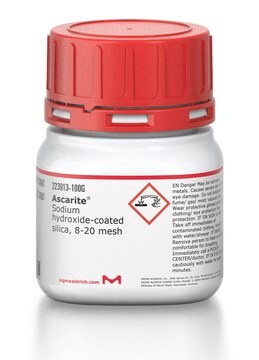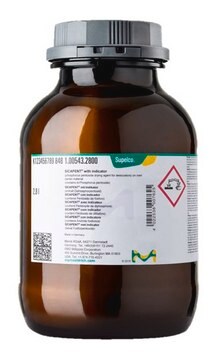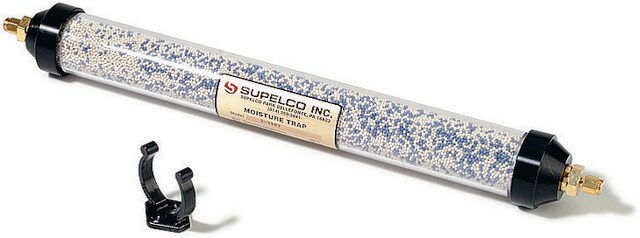223921
Ascarite®
Sodium hydroxide-coated silica, 20-30 mesh
Sinónimos:
Ascarite CO2 adsorbent
Iniciar sesiónpara Ver la Fijación de precios por contrato y de la organización
About This Item
Productos recomendados
Nivel de calidad
Formulario
granular
tamaño de partícula
20-30 mesh
cadena SMILES
[Na+].[O-H]
InChI
1S/Na.H2O/h;1H2/q+1;/p-1
Clave InChI
HEMHJVSKTPXQMS-UHFFFAOYSA-M
¿Está buscando productos similares? Visita Guía de comparación de productos
Descripción general
Ascarite® is sodium hydroxide coated silica mainly used as carbon dioxide adsorbents. It is the second generation of the original Ascarite, which was derived from granular asbestos. Ascarite rapidly and quantitatively adsorbs carbon dioxide, (and acid gases), and is useful in a number of analytical and microanalytical procedures, physiological studies, etc.
Aplicación
Ascarite® can be used as a carbon dioxide (CO2) trap.
Características y beneficios
The material is self-indicating, gradually changing color (to white) within a narrow zone due to the formation of sodium carbonate.
Información legal
Ascarite is a registered trademark of Arthur H. Thomas Co.
Palabra de señalización
Danger
Frases de peligro
Consejos de prudencia
Clasificaciones de peligro
Eye Dam. 1 - Met. Corr. 1 - Skin Corr. 1A
Código de clase de almacenamiento
8B - Non-combustible corrosive hazardous materials
Clase de riesgo para el agua (WGK)
WGK 3
Punto de inflamabilidad (°F)
Not applicable
Punto de inflamabilidad (°C)
Not applicable
Equipo de protección personal
Eyeshields, Faceshields, Gloves, type P3 (EN 143) respirator cartridges
Elija entre una de las versiones más recientes:
¿Ya tiene este producto?
Encuentre la documentación para los productos que ha comprado recientemente en la Biblioteca de documentos.
Los clientes también vieron
Reduction of [11C] CO2 to [11C] CO using solid supported zinc.
Dahl K, et al.
Journal of Labelled Compounds & Radiopharmaceuticals, 60(13), 624-628 (2017)
Highly selective iron-based Fischer?Tropsch catalysts activated by CO2-containing syngas
Chun D H, et al.
J. Catal., 317, 135-143 (2014)
Weiqing Liu et al.
Carbohydrate polymers, 93(1), 199-206 (2013-03-08)
Dissolution of waxy corn starch in 1-ethyl-3-methylimidazolium acetate (EMIMAc) was qualitatively studied and compared with gelatinisation process in water. The rheological properties of starch-EMIMAc solutions were investigated in dilute and semi-dilute regions, from 0.1 to 10 wt% over temperature range
Qiang Yu et al.
Bioresource technology, 129, 592-598 (2013-01-12)
Liquid hot water (LHW), dilute hydrochloric acid (HCl) and dilute sodium hydroxide (NaOH) were applied to sugarcane bagasse (SB). Application of the same analytical methods and material balance approaches facilitated meaningful comparisons of glucose and xylose yields from combined pretreatment
Xin-Cun Yao et al.
Carbohydrate polymers, 94(1), 88-90 (2013-04-03)
Most polysaccharides cannot dissolve in water but can be hydrolysed using hydrogen peroxide (H2O2) to yield a water-soluble product. This study presents a method of preparing water-soluble polysaccharides from peach gum by hydrolysis using H2O2. Extraction was monitored by the
Global Trade Item Number
| Número de referencia del producto (SKU) | GTIN |
|---|---|
| S220744-1EA | |
| 223921-100G | 4061838778826 |
| 223921-2.5KG | 4061833545348 |
| 223921-500G | 4061835252879 |
Nuestro equipo de científicos tiene experiencia en todas las áreas de investigación: Ciencias de la vida, Ciencia de los materiales, Síntesis química, Cromatografía, Analítica y muchas otras.
Póngase en contacto con el Servicio técnico







